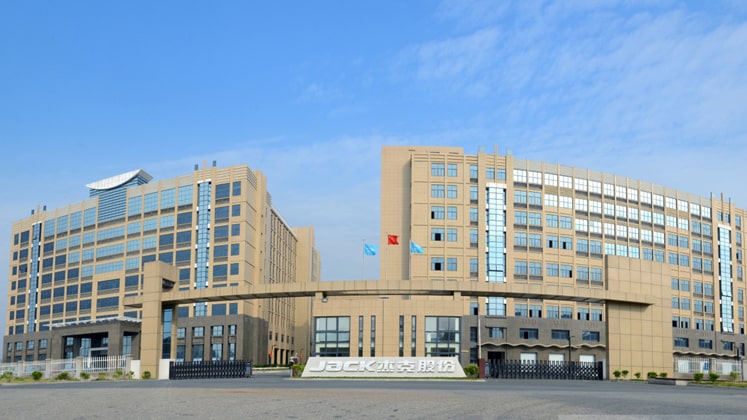
Jack Stock needs no introduction! This leading China-based apparel technology group has been aggressively penetrating different market segments with a lot of acquisitions and mergers since 2015. It was 2017 when Jack started working on the Internet of Things (IoT) concept for sewing industry and launched the same in 2019. The Jack IoT has been making headlines since then with its cost-effectiveness, a wide integration of huge product portfolio, and a complete digitalisation from fabric till dispatch.
Apparel Resources got in touch with Vincent Guo, Director and Vice President of Jack Stock, China, recently to talk about the latest developments in Jack IoT technology and how the company is moving forward to establish the same in the ‘cash-crunched’ market during the post-COVID-19 era.
To make IoT an indispensable part of apparel manufacturing industry, it needs to be there in every type of machine. Jack already has IoT in sewing machine; what is the status of integration of spreading, cutting, and other sections?
Vincent: You are right! Digitalising only sewing process doesn’t solve the factory production woes; total digital solution for each and every department within a factory in order to integrate those altogether is the need of the hour. A garment factory has four main zones – fabric storage and cutting, production, finishing, and dispatch. And, there are a lot of processes carried in each of these zones which involve a lot of data that need to be managed and controlled. Our IoT is meant to digitise all this data. We can synchronise our IoT with finishing machines, cutting machines, warehouses, and of course, sewing machines.
This data integration is done in two ways: (1) the users can submit the data to cloud, and (2) we can deploy data locally in the servers of the users. We use a gateway to transfer data from IoT to cloud and using the same gateway, the partner factories can transfer data from IoT to their local servers. By default, the data is transferred to cloud but, if customer requests, we can assist them in transferring their data to local server using a MQTT protocol which we have developed in-house.
Therefore, we are making all these processes (cutting, sewing, finishing, and warehouse) intelligent through our IoT. We use data to analyse the trend and come out with a decision to improve quality management system, efficiency of shop floors and factory, reduce delivery time and increase overall productive output.
Jack is leading the trend in sewing machine IoT technology with two-way communication (between sewing machine and PDA device). Why adoption rate of IoT is still very low and slow in the industry?
Vincent: For Asian customers, integrating IoT in garment manufacturing is comparatively new. I believe there are two reasons for the same – (1) most of the available technologies are not mature, and (2) the cost of this technology is quite high. Moreover, the factories are still not educated about how IoT works and what kind of long-term benefits they can obtain using it.
However, in recent 2 years, the cost of IoT has decreased drastically, and as a result, adoption rate of IoT in China is increasing rapidly. In the past, only large-scale companies had the ability to purchase IoT-enabled sewing machines but now, as I can see, medium and small factories are also embracing this technology, particularly in China as they have understood amidst rapidly disrupting (evolving) market that total solution for the growth of manufacturing sector depends not only on hardware, but on software too.
When it comes to India, Vietnam and Bangladesh, the adoption rate is still low and only those large-scale factories are implementing IoT which get a nod from the progressive and reputed buyers like H&M, Nike, and adidas among many others. These buyers first check and evaluate operations on a sample IoT machine and then decide whether to use IoT in entire production lines. I would want to make a strong point here. In China, we industrialise digitisation and the commercial environment is better here than India, Vietnam, and Bangladesh or any other Asian country. We have more specialised companies which provide MES, APS, WMS, WCS and other customised mobile apps designed for the garment industry; the software companies provide quite a simple yet comprehensive software to factory owners; and 5G is already here in China now which is not there in India, Bangladesh or in Vietnam. We have a lot of cloud service providers in China and SMEs don’t have to purchase their own software because of availability if cloud-based providers such as Huawei, Tencent and Alibaba.
When it comes to countries other than China, most of the traditional factories don’t even know how high the risk is in their working atmosphere and the cost involved in the same, but if they are digitalised, they would better know the financial status of their processes. They need to understand that IoT can help their buyers know the status of the orders, and if any issue arises in any of the departments, the factory people and buyers can team up instantly to solve the issue using their expertise. What’s more important is that digitisation can ‘visualise’ the problem of the garment factories.
IoT should play a critical role in predictive maintenance of machines. However, every player (including Jack) is emphasising more on production data, why is it so? Is Jack planning to advance its IoT reach from production data to predictive maintenance?
Vincent: There are a lot of differences between the use of IoT in garment industry and in other industries. The industries like aerospace, automobile emphasise more on predictive maintenance which is an essential thing to do in their sectors. You can see IoT-enabled auto cutters which can be used in either of apparel, aerospace or automobile sector. But, to be honest, the use of IoT in predictive maintenance of sewing machines is not as important as aerospace or automotive sector. In garmentindustry, factories are more interested in knowing how machinescan improve garment quality, increase productivity and reduce time of operation. Our aim is not just IoT for sewing, but on how to transform a traditional factory into a digital factory which I have already explained. We have already introduced predictive maintenance function in some high-priced equipment like auto-cutters (Bullmer), hanger system (Yikeda).
How do you see the market growing post-COVID-19? Will market slowdown due to ‘short of cash’? Or, demand for IoT will increase (as more companies will go for a smart factory)?
Vincent: IMF and World Bank projections say this year we can be optimistic but economy will boost only from mid-2021. But I’m sure there will be more factories which will adopt digital solutions, as there is no other way for surviving in the post-pandemic era. The entire supply chain will be looked upon by the industry stakeholders and digital technologies will be integrated to operate ruptured supply chains. If manufacturers want to work in collaboration with buyers effectively, I can see no other option than opting for IoT as well as the implementation of other digital solutions. Since sewing machine industry is on the rise, IoT will be a clear winner.
What is Jack’s market estimate for IoT sewing machine in coming 5 years? How much percentage of total sewing machines in India/Bangladesh/Vietnam will adopt IoT for becoming smart factory? Can you give yearly projection in 2021 and in 2025?
Vincent: Perhaps adoption of IoT for sewing machines in China and Vietnam will be higher than India and Bangladesh. Our prediction says 1,00,000 IoT-enabled sewing machines will be sold by 2021 globally, while this number will reach 1 million by 2025. Jack proudly predicts to capture 35 per cent of the whole IoT industry market share in sewing machine.
What will be your core strategy to convince probable customers to invest in your IoT technology in the post-pandemic era?
Vincent: We have already started identifying the customers who follow progressive business approach. Our plan includes establishing sample IoT factories in different countries and educating our dealers so that they don’t have an iota of doubt while explaining the same to the factories.To start with, we can introduce IoT in just one production line of a factory and won’t target to implement it in entire factory at once. Once the factory owners see the positive changes, ROI and long-term organised production line, we will then target and deploy it in entire factory.
We have practical examples to share with them and convince them. For example, in template sewing machine, previously one by one manual changing of patterns used to take place, but now with Jack IoT, we can synchronise new patterns using cloud system to more than one machine simultaneously even from remote. Template machines don’t have to stop meanwhile.
Finally, I would like to send a message to the industry that, in garment factories, there is a lot of scope for improvement regarding adoption of digitalisation and IoT that can help them improve quality and management efficiencies, and at the same time, reduce cost and delivery time. Jack has been aggressively working to eliminate prolonged barriers to improve factories’ efficiencies from 2015 till date. We have done a lot of acquisitions in last 5 years, and now we can provide total solutions to garment factories which include both software and hardware. We invite all garment factory owners to visit our factory in China to see our production methods on their own before deciding to invest in our technologies.
Also Read: ‘Next Normal’ will focus on digitalisation to reset ruptured supply chain: Lectra’s Daniel Harari







